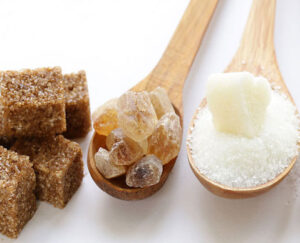For the first time in more than 20 years, the U.S. Food and Drug Administration (FDA) has updated the Nutrition Facts label on packaged foods and beverages. Of the major changes, the one most talked about ingredients by industry and the consumer is added sugars.
What is an Added Sugar?
According to the FDA, added sugars are sugars and syrups that are included during the processing or preparation of food and beverages, packaged sweeteners (such as a bag of table sugar), and concentrated fruit or vegetable juices. Added Sugars may appear as sucrose, table sugar, invert sugar, brown sugar, raw sugar (turbinado or demerara), corn sugar, corn sweetener, corn syrup, dextrose, fructose, glucose, high-fructose corn syrup, honey, lactose, molasses, rice syrup and tapioca syrup.
However, when looking at food labels, added sugars do not include sugar that is naturally found in foods like fruit or milk, fruit or vegetable juice concentrated from 100% juices, or fruit juice concentrates used as fruit part of jellies, jams or preserves.
Breaking Down Total Sugars
When looking at the sugar content of any food, it’s important to look at the food labels which combine both the naturally occurring sugars and the sugar added during processing. Compared to the original label, the new label separates sugars into two categories: total sugars and added sugars with percent of daily value (%DV). The %DV is the amount of the nutrient in a single serving or packaged item based on an average 2,000 calorie diet. The daily value (DV) for added sugars is 50 grams per day; there is no %DV for total sugars.
Why the Label Change?
Every five years, the U.S. Department of Health and Human Services (HHS) and the U.S. Department of Agriculture (USDA) release a new edition of the Dietary Guidelines for Americans. The guidelines are based on the latest scientific data and research. The 2015-2020 guidelines focus on making small changes to your daily eating habits, exercise regularly and think about eating patterns rather than singling out individual nutrients. Healthy eating includes more vegetables, fruits, whole grains, dairy and lean meats while also limiting sodium, saturated fat, and added sugars (less than 10 percent of total calories per day). The new Nutrition Fact label has been updated to help consumers make smart choices to meet these guidelines.
What do Consumers Think?
According to the International Food Information Council Foundation’s 2019 Food and Health Survey, limiting sugar intake is the number-one change Americans want to make in their diets — followed by eating more fruits and vegetables and eating fewer carbs to control consumers’ weight. Survey respondents report that the added sugars they consume come from sugar-sweetened beverages, baked goods and sweets. Most are now choosing to limit their sugar intake by drinking more water, eliminating certain foods and beverages from their diet and monitoring their total carbohydrates.
Finding the Right Sugar and Sugar Substitute Balance
Taste and price are the two top motivators when purchasing food, however, Americans are also seeking foods that provides a health benefit. While there is no one size fits all solution to reduce sugar, food scientists have several tools to work with. Many are turning to plant-based sweeteners such as stevia and monk fruit, erythritol, prebiotics such as inulin and flavor enhancers.

One alternative rising in popularity is Allulose. Allulose is a rare sugar similar to sucrose in taste and functionality while having 90% fewer calories. The Allulose trend spiked when the FDA announced that Allulose does not need to be counted as total sugars or added sugars but instead be labeled under total carbohydrates.
Not only does sugar provide the sweetness that we are used to, but it also adds texture, enhances flavor, is a humectant and can extend the shelf life of products. Finding the best solution can be a challenge.
Sugar isn’t just about sweetness—it plays a crucial role in texture, flavor, moisture retention, and shelf life. Finding the right balance between sugar and alternatives can be complex, but we’re here to help. Connect with our ingredient experts today to discover the best sweetening solutions for your products
Frequently Asked Questions:
What is the difference between no added sugar and unsweetened?
A product labeled “no added sugar” means no sugars or sugar-containing ingredients were added during processing. However, it may still contain naturally occurring sugars, such as those found in fruit or milk.
“Unsweetened” generally indicates that no sweeteners—natural or artificial—were added to the product, though it may still contain natural sugars.
Why do some products list added sugars even if they don’t taste sweet?
Added sugars aren’t just used for sweetness—they also serve functional purposes in food. They help with texture, browning, moisture retention, and preservation. For example, sugar is added to bread to help with fermentation, to sauces to balance acidity, and to processed meats to enhance flavor and extend shelf life.
Are sugar alcohols considered added sugars?
No, sugar alcohols (like erythritol, sorbitol, and xylitol) are not classified as added sugars by the FDA. These sweeteners provide sweetness with fewer calories and a lower impact on blood sugar. However, some processed foods that use sugar alcohols may also contain added sugars, so it’s important to check labels carefully.
Do artificial sweeteners count as added sugars?
No, artificial sweeteners like aspartame, saccharin, and sucralose are not considered added sugars because they do not contribute calories or carbohydrates. However, some products that use artificial sweeteners may still contain added sugars for texture, flavor, or stability, so checking the ingredients list is essential.
Summer M McQuoid, NDTR
Sales Representative
Sweetener Products Company
Contact us.
Sources:
Dietary Guidelines for Americans 2015-2020 – U.S. Department of Health and Human Services
U.S Food and Drug Administration – Food & Nutrition Labeling
International Food Information Council Foundation – 2019 Food and Health Survey
Center for Disease and Control
